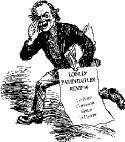
 |
 |

| Saturday, April 20, 2024 |
Miles from the Mainstream |
D.
R. ZUKERMAN, proprietor |
Abolish NCAA Seedings;
Pair the Teams by Lot
April 1, 2014 -- LPR believes it is time to replace seedings for the NCAA men's and women's basketball tournaments, known more familiarly as March Madness, with first game match-ups chosen by lot. Annually, selection of the 64 teams in the men's competition (not including "play-in" games) is announced during a mid-March Sunday evening television program by reference to seeds. There are 16 teams in each of the four NCAA regions: South, East, Midwest and West. (The teams are not necessarily assigned to regions on the basis of geography.This year, for example, the University of Massachusetts found itself competing in the Midwest region, and Syracuse University played in the South region.) The seedings, LPR understands, are based on the NCAA tournament selection committee's expectations of the teams that will comprise the "Final Four" -- that is, the tournament's semi-final and final rounds. Sixteen teams compete in each of the four regions. Teams seeded 9 through 16 are expected to lose in match-ups with teams 1 through 8. A No. 1 seed is matched against a No. 16 seed, a no. 2 seed is matched against a No. 15 seed, a No. 3 against a No. 14, etc. The No. 1 seeds are the teams expected by the NCAA selection committee to comprise the Final Four. (The top No. 1 seed is the team expected by the selection committee to be the NCAA tournament champion.) The No. 2 seeds are expected to play in the regional finals and lose to the No. 1 seeds. The No. 3 and 4 seeds are expected to reach the regional semi-finals, and lose to the No. 1 and No. 2 seeds. For the 2014 men's NCAA basketball tournament, one of the four No. 1 seeds reached the Final Four: the University of Florida. The University of Wisconsin, another Final Four team, as a No. 2 seed, was expected to lose in its regional final to the No. 1 seed, the University of Arizona. The University of Connecticut, third member of the Final Four, this year, was expected, as a No. 7 seed in the East, to lose to No. 2 Villanova, who, in turn, was expected to lose to No. 1 Virginia. The remaining member of the Final Four, the University of Kentucky, as a No. 8 seed in the Midwest (another geographical curiousity), was expected to lose to No. 1 seed Wichita State, after winning its first game. Instead, Kentucky defeated WIchita St -- but did not become the performance-based No. 1 in its region until it defeated the University of Michigan in the Midwest regional final. Michigan, as a No. 2 seed, did precisely as the selection committee expected, however little solace this will provide Wolverine fans. Although Michigan State lost to Connecticut in the East regional final, the Spartans, in reaching the East regional final, outperformed its No. 4 seeding. The selection committee struck out in its East and South seedings; no team performed as expected. The committee did better in the South, where four of the 16 competitors matched committee expectations. The committee's best seeding record in the tournament was in the Midwest where eight of the 16 teams performed as expected. If the LPR's proposal to replace seedings with pairings- by- lot is unacceptable, the selection committee's seedings should be adjusted to reflect the actual progression of the tournament. The listings below show the performance seedings to the left of the team name, with the original seeding to the right. For example, in the South region, No. 3 seed Syracuse would be adjusted to a No. 7 seed.
South 1. Florida 1 East 1. UConn 7 |
West 1. Wis. 2 Midwest 1. Kentucky 8
How did the selection committee do in its seeding, say, of Dayton in the South? The committee misunderestimated Dayton by a factor of 9. And see Harvard's No. 12 seed in the East, adjusted to a performance 7 seed. Clearly, the selection committee assumed, notwithstanding Harvard's first game win, last year, that an Ivy League school could not win a tournament game. In the Midwest, the committee expected Duke to get to the "Sweet Sixteen." The performance seed drops Duke from a No. 3 to a No. 11. In the South, reality drops Ohio State from a No. 6 to a No. 15. Notwithstanding the stature of Duke and Ohio State as basketball powers, their 2014 tournament performance seedings reflect the failure to win their opening game. Seedings make sense for a conference tournament, perhaps, where they reward performance in the closed environment of conference play. There is no similar, closed, environment in the context of the NCAA 64- team field. Let the selection committee do its work, confirming automatic choices and choosing the other participants in the NCAA basketball tournament, and then let chance determine the opening match-ups. To the argument that this might result in top teams meeting in an opening round rather than in the Final Four, experience shows that NCAA tournament reality usually does not comply with the selection committee's expectations. Just consider the 2014 NCAA Final Four: a No. 1 against a No. 7; a No. 2 against a No. 8, in games won by the No. 7 and No. 8 seeds. Would chance yield more curious match-ups? Besides, the 2014 NCAA Men's Division I Basketball Tournament clearly provided plenty of exciting games in the early phases of the tournament as well as in the concluding rounds.
David R. Zukerman. prop.
|
|

